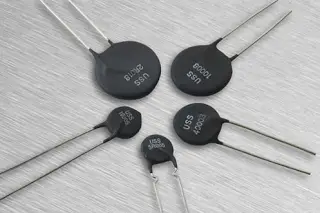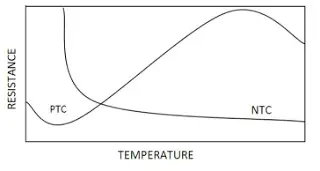 |
| Fig. NTC Thermistors (source: ussensor.com) |
Thermistors
Contents
show
These are the thermally sensitive resistors. The resistance of a thermistor varies as a function of temperature. The thermistor is also called thermal resistors. It is a resistive temperature transducer.
Thermistors are composed of semiconductor materials. It is composed of a sintered mixture of metallic oxides such as Mn, Ni, Co, Cu and Fe. Most thermistors behave as resistors with high negative temperature coefficient i.e. their resistance decreases with the increase of temperature. This property of thermistors enables the thermistor to detect very small changes in temperature as compared to RTD or thermocouple.
Types of Thermistors
Generally, thermistors are of two types as
1. Positive temperature coefficient (PTC) thermistor
2. Negative temperature coefficient (NTC) thermistor
In PTC type thermistor, resistance increase with increase in temperature. Whereas in NTC thermistor, resistance decrease with increase in temperature.
Note: Pure metals have positive temperature coefficient (PTC) of resistance, alloys have nearly equal zero temperature coefficient of resistance and semi conductors have negative temperature coefficient (NTC) of resistance.
Features of Thermistor
- Thermistors are at least 10 times as sensitive as the platinum Resistance temperature detector (RTD).
- This high sensitivity of thermistors is very useful for precision temperature measurement, control and compensation.
- Although thermistors are very sensitive but on the other hand, it exhibits highly non-linear characteristics of resistance versus temperature.
- Thermistors are available in variety of sizes and shapes
- Thermistors are compact and rugged in construction.
- It is widely used in the application where temperature measurements ranges -60 °C to 15 °C.
Thermistors Characteristics
There are three important characteristics of thermistors as given below.
1. Resistance vs Temperature characteristics
2. Voltage vs Current characteristics
3. Current vs Time characteristics
Applications of thermistors
1. The very first application is in the measurement of temperature.
2. Thermistors are used in circuits to control temperature.
3. They are used to compensate for the effects of temperature on conductor or circuit performance.
4. It is used in the measurement of power at high frequencies.
5. Thermistors are used to provide time delay in circuits.
6. It is used in the measurement of thermal conductivity.
7. It is used in the measurement of composition of gases.
8. Thermistors are used for the measurement of level, flow, and pressure of liquids.
Excercise
Q. Why is thermistor well suited to precision temperature measurement, control and compensation?
Ans. Thermistors are well suited to precision temperature measurement, control and compensation because they are rugged in construction, cheap and highly sensitive devices.
Q. What is the application of PTC thermistors?
Ans. PTC thermistors can be used as heating elements in small temperature controlled ovens.
Q. What are the application of NTC type thermistors?
Ans. NTC thermistors can be used as inrush current limiting devices in power supply circuits. It is also used for temperature compensation i.e. for cancelling the effect of temperature on other electronic devices. It is also used for measurement and control of liquid flow, temperature, gas flow, etc.
Q. Why most of the thermistors have negative temperature coefficient?
Ans. The reason is that when thermistors temperature is increased, the concentration of charge carriers increases resulting in a decrease in resistance.
Ans. The reason is that when thermistors temperature is increased, the concentration of charge carriers increases resulting in a decrease in resistance.

